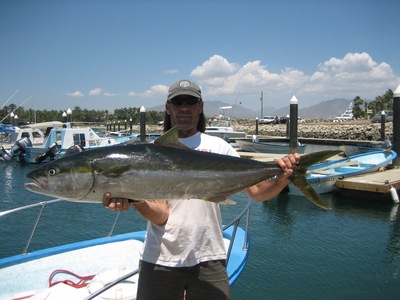May 24, 2009
Anglers –
With travel alerts now lowered we are seeing a few more tourists visiting, but overall numbers are significantly low considering this time of year is generally a busy time. The official summer season begins in a month. This is the season when northern trade winds give way to increasingly dominating southern wind patterns, this contributes to pushing in cooler green Pacific currents. Seems to form a cycle that will push in murky dirty water and then will clear up within several days and then perhaps more south wind will sweep in the green current once again, repeating this pattern, until finally the consistent warmer weather conditions stabilize and clean blue water can be found close to shore throughout summer and into the fall. At this time the water has been ranging from the mid 60s on the Pacific side of Cabo San Lucas, to highs of 78 to 80 degrees offshore of San Jose del Cabo. There were a wide range of weather patterns this past week, starting with thick marine fog and hung around throughout the mornings for a couple of days and limited options for fleets, at times visibility was down to less than 50 yards. Then there were a couple of mornings where there was light rain fall that never really amounted to much.
Overall anglers enjoyed favorable ocean swells, which was appreciated, since the striped marlin bite has been found in offshore waters from 12 to 20 miles straight out front of San Jose del Cabo, main action centered around the 1150 Bank. Using available cabaillito and mullet bait fish in combination with trolling surface lures there were good numbers striped marlin found. Most charters that targeted the billfish accounted for one to three stripers per outing. At times the fish were not easy to hook, apparently still getting their full of the plentiful squid now congregated on the fishing grounds. The marlin were definitely dominating the offshore activity, not many encounters with tuna reported and only a scattering of dorado showing up in the counts.
High surf conditions have made it difficult and hazardous for the commercial pangueros to net sardinas, which typically congregate inside the surf zone. Virtually no sardinas are now being netted out of La Playita, only mullet and caballito. Sardinas are schooling off the beaches towards the East Cape, but they are either out of range of local pangas or in areas where wave action does not allow for boats to reach the baitfish. With the lack of small baitfish in combination with dirty green water conditions has really limited panga fleets what they were able to do. Trolling or drift fishing with these baits did produce limited numbers of species including, amberjack, yellowtail, pompano, roosterfish, cabrilla and dog tooth snapper. As the clarity of the water improves this inshore action should really heat up in the coming weeks. We will keep our fingers crossed that sardinas become available soon, so that we can get more chum in the water and increase opportunities for surface action.
Giant squid are still in the area, creating problems on the inshore fishing grounds where they have moved in and scattered all of the yellowtail, amberjack and other species that had been providing sport for anglers. One place being a small reef, which is less than one mile offshore from Palmilla Point, this area had been producing consistent respectable numbers of yellowtail, averaging 10 to 15 pounds, with an occasional 25 to 30 pound fish in the mix, also some amberjack and cabrilla, anyway, this bite completely evaporated over the weekend as the giant squid had taken over and certainly made quick work out of cleaning the spot out of fish. The technique off of Palmilla has been to use yo-yo jigs, or even better yet, to slow trolling with oily sardineta dead baits, using a down rigger at 80 to 100 feet. Problems can be finding this supply of sardineta baitfish(they are found mixed with mackerel) and then a boat with a downrigger.
The combined panga fleets launching out of La Playita/Puerto Los Cabos sent out approximately 48 charters for the week with anglers reporting a fish count of:
18 striped marlin, 2 mako shark, 6 yellowfin tuna, 11 dorado, 19 cabrilla, 89 various pargo species, 9 yellowtail, 17 amberjack, 10 jack crevalle, 14 Mexican bonito, 23 roosterfish, 16 pompano and 18 sierra.
Good Fishing, Eric

